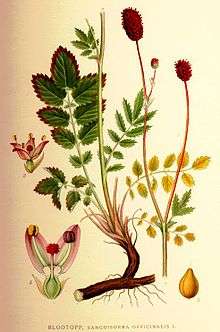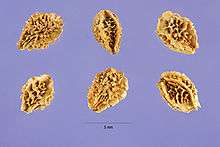Sanguisorba officinalis
| Great burnet | |
|---|---|
 | |
| Scientific classification | |
| Kingdom: | Plantae |
| (unranked): | Angiosperms |
| (unranked): | Eudicots |
| (unranked): | Rosids |
| Order: | Rosales |
| Family: | Rosaceae |
| Genus: | Sanguisorba |
| Species: | S. officinalis |
| Binomial name | |
| Sanguisorba officinalis | |
Sanguisorba officinalis (great burnet) is a plant in the family Rosaceae, subfamily Rosoideae. It is native throughout the cooler regions of the Northern Hemisphere in Europe, northern Asia, and northern North America.
It is a herbaceous perennial plant growing to 1 m tall, which occurs in grasslands, growing well on grassy banks. It flowers June or July.[1]
Sanguisorba officinalis is an important food plant for the European large blue butterflies Maculinea nausithous and M. teleius.[2]
Commercial uses

Use is made of its extensive root system for erosion control, as well as a bioremediator, used to reclaim derelict sites such as landfills.
Ethnomedical uses
It has been used in traditional Chinese medicine (TCM) where it is known by the name Di Yu. It is said to cool the blood, stop bleeding, clear heat, and heal wounds (Chinese Herbal Materia Medica by Dan Bensky).
Specifically, the root is used to stop bloody dysentery, nosebleeds, and is applied topically to treat burns and insect bites.
Biology
Polysaccharides extracted from Sanguisorba officinalis displayed antioxidant activities[3] .Ethanol extracts of Sanguisorba officinalis roots were shown to exert anti-inflammatory effects.[4] The root extract was also shown to have FGF5 inhibitory effects which resulted in reduced hair loss.[5]
note: the study referenced above to support FGF5 inhibition is not available in english. To date there are very little data available regarding sanguisorba officinalis mediatiated inhibition of FGF 5.
Chemistry
Sanguiin H-6 is a dimeric ellagitannin that can be found in S. officinalis.[6]
Ziyuglycoside II is a triterpenoid saponin that can be found in S. officinalis.[7]
References
- ↑ Plants for a Future: Sanguisorba officinalis
- ↑ World Conservation Monitoring Centre 1996. Maculinea nausithous . 2006 IUCN Red List of Threatened Species. Downloaded on 6 October 2010
- ↑ Zhang L, Koyyalamudi SR, Jeong SC, Reddy N, Smith PT, Ananthan R, Longvah T (December 2012). "Antioxidant and immunomodulatory activities of polysaccharides from the roots of Sanguisorba officinalis". Int. J. Biol. Macromol. 51 (5): 1057–62. doi:10.1016/j.ijbiomac.2012.08.019. PMID 22944198.
- ↑ Yang JH, Hwang YH, Gu MJ, Cho WK, Ma JY (December 2015). "Ethanol extracts of Sanguisorba officinalis L. suppress TNF-α/IFN-γ-induced pro-inflammatory chemokine production in HaCaT cells". Phytomedicine. 22 (14): 1262–8. doi:10.1016/j.phymed.2015.09.006. PMID 26655409.
- ↑ Maeda, T.; Yamamoto, T.; et al. 2007 (2007). "Sanguisorba Officinalis Root Extract Has FGF-5 Inhibitory Activity and Reduces Hair Loss by Causing Prolongation of the Anagen Period". Nishinihon Journal of Dermatology. 69 (1): 81–86. doi:10.2336/nishinihonhifu.69.81.
- ↑ Bastow KF, Bori ID, Fukushima Y, Kashiwada Y, Tanaka T, Nonaka G, Nishioka I, Lee KH (June 1993). "Inhibition of DNA topoisomerases by sanguiin H-6, a cytotoxic dimeric ellagitannin from Sanguisorba officinalis". Planta Med. 59 (3): 240–5. doi:10.1055/s-2006-959659. PMID 8391144.
- ↑ Zhu X, Wang K, Zhang K, Zhu L, Zhou F (May 2014). "Ziyuglycoside II induces cell cycle arrest and apoptosis through activation of ROS/JNK pathway in human breast cancer cells". Toxicol. Lett. 227 (1): 65–73. doi:10.1016/j.toxlet.2014.03.015. PMID 24680927.